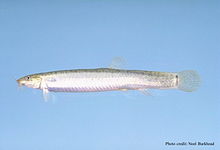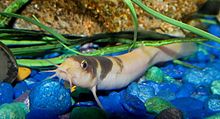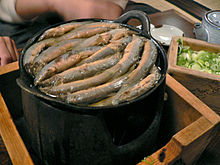- Misgurnus anguillicaudatus
-
Weather loach 
Scientific classification Kingdom: Animalia Phylum: Chordata Class: Actinopterygii Order: Cypriniformes Family: Cobitidae Subfamily: Cobitinae Genus: Misgurnus Species: M. anguillicaudatus Binomial name Misgurnus anguillicaudatus
(Cantor, 1842)The Dojo Loach (Misgurnus anguillicaudatus), is a freshwater fish in the loach family Cobitidae. They are native to Asia but are also popular as an aquarium fish. The alternate name weather loach is shared with several other Cobitinae, including the other members of the genus Misgurnus and the spotted weather loach (Cobitis taenia, commonly known as Spined Loach). This term comes from their ability to detect changes in barometric pressure and react with frantic swimming or standing on end. This is because before a storm the barometric pressure changes, and this is known to make these fish more active. The weather loach also comes in a variety of colors, such as pink, orange, and gray.
Like many other loaches, they are slender and eel-like. They can vary in color from yellow to olive green, to a common light brown or gray with lighter undersides. The mouth of the loach is surrounded by three sets of barbels. It uses them to sift through silt or pebbles to find food. It also uses them to dig under gravel and sand to conceal itself out of nervousness or defense unlike the other loaches who use the spines beneath the eyes.
They can grow up to a 12 inches (30.5 cm) long. The fish are bottom-dwelling scavengers, feeding mainly on organic material such as algae. Weather loaches are omnivorous and may also feed on tubifex worms and other small aquatic organisms. By producing a layer of mucus to keep themselves damp, they can also survive small periods of not being in the water. They are very hardy fish that can live in poor quality water.
One thing that makes this fish unique among the other tropical fish you see at your average fish store is the fact that they thrive at room temperature (68-72°F) and even as low as upper 50's. The usual tropical temperature will result in a significantly reduced lifespan (from an average 10 years to four or less). One assumes when buying tropical freshwater fish that all will thrive in that 76-82 range; not so with the dojo.
Sometimes this fish (especially the golden variety) is mistaken for the kuhli loach. The kuhli likes warm tropical temperatures, will tolerate more acidic conditions, and matures at a much smaller four inches. Very different fish, but may resemble each other while young, and at the usual age and size of what most fish stores market.
Contents
In the aquarium
Weather loaches are active, peaceful, and hardy fish that are sometimes used as starter fish in an aquarium. They can be "friendly" towards humans, allowing physical contact and hand feeding. They have, however, been known to attack very small fish in smaller aquariums. They get along better with goldfish.
There are other varieties bred from captivity like the gold strain and the peppered strain (not to be confused with the pepper loach).
The loaches will be more active given more space and greater numbers. Solitary weather loaches tend to spend much of their time hiding. They will spend a lot of time hiding or staying still, but should be given a place to stay which will have cover and shade. Tank decorations that they can swim through and driftwood both work great for this. Due to their jumping ability the average cover should be enhanced with tape or other barriers. However, if you happen to find your loach black and dry on the floor one morning, try placing it back in the aquarium. Usually it will revive and swim away and make a full recovery. In some cases, it has been reported that they can live up to three days out of a tank. Also, they may even travel up tubes and take up residence in filters, so check there if your dojo doesn't show up for roll call one day. Weather loaches enjoy digging and burrowing themselves in the substrate of their tank, so make sure that your substrate is fine enough for them to dig in. If you keep live plants in your tank, they will be uprooted by the loaches, so it is a good idea to weight your plants. The weather loach is also peculiar in that it will sometimes bury itself in the substrate during times of stress. This often surprises new owners, as the fish will "disappear" shortly after introduction to the tank only to "reappear" later.Because of their appetite for snails, these loaches can help alleviate snail infestations in tropical fish tanks, though many have reported that while weather loaches do eat snails, they do not eat them at a fast enough rate to deal with an infestation.
The fish prefer a pH of 6.5-8.0 but will tolerate far more acidic conditions even for extended amounts of time with little negative reaction. This makes the Weather Loach a great choice for first-time aquariums and for those who want a fish tank but do not want the intense, daily attention other fish require. This fish should be kept in groups of at least 3, as they like to be in physical contact with each other and feel each other with their barbels when they rest.
As food
The weather loach is a common food fish in East Asia, raised on a large scale in fish farming.
See also
- Loach
- European weather loach
References
Bibliography
- "Misgurnus anguillicaudatus". Integrated Taxonomic Information System. http://www.itis.gov/servlet/SingleRpt/SingleRpt?search_topic=TSN&search_value=163978. Retrieved 30 January 2006.
- Froese, Rainer, and Daniel Pauly, eds. (2005). "Misgurnus anguillicaudatus" in FishBase. 10 2005 version.
- [1]
- "New Invasive Fish Spreads Through The Ebro Delta". Science News (Science Daily). 2009-01-20. http://www.sciencedaily.com/releases/2009/01/090114095105.htm. Retrieved 2009-01-20.
- Franch, Nati; Miguel Clavero, Montse Garrido, Norbert Gaya, Veronica Lopez, Quim Pou-Rovira and Josep Maria Queral (2008). "On the establishment and range expansion of oriental weatherfish (Misgurnus anguillicaudatus) in NE Iberian Peninsula". Biological Invasions 10 (8): 1327. doi:10.1007/s10530-007-9207-9.
External links
Categories:- Misgurnus
- Cold-water aquarium fish
- Edible fish
- Commercial fish
Wikimedia Foundation. 2010.



